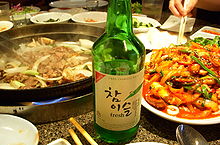Anju (food)

|
|
| Type | Noodle soup |
|---|---|
| Place of origin | Korea |
| Main ingredients | various |
| |
|
| Korean name | |
| Hangul | 안주 |
|---|---|
| Hanja | 按酒 |
| Revised Romanization | anju |
| McCune–Reischauer | anju |
| IPA | [an.dʑu] |
Anju (안주; 按酒) is a general term for a Korean food consumed with alcohol. It consists of a variety of foods, including both main dishes and side dishes. Consuming food with alcohol is a widespread practice in Korea, especially when the alcoholic beverage soju is involved.
Certain types of foods consumed primarily as Anju include golbaengi muchim, nogari with peanuts, and jokbal.
Until the Chosun Dynasty, alcohol was mainly served in jumaks (a type of inn or tavern), where soups with rice, along with traditional alcohol such as makgeolli, were served to guests. Since the introduction of beer and Western foods into Korea, mainly from Japan in the nineteenth century, bars and pubs have enjoyed a newfound popularity, and many types of Western foods have been consumed as anju. nowadays, anju is good market source of grocers.
Some foods are considered to be best complemented by certain types of alcohol. For example, samgyeopsal, grilled pork belly, is considered to go best with soju, while fried chicken or Korean seasoned chicken goes well with beer. Pa-jun and makkeoli (or dongdongju) is a popular combination for rainy days.
There are a number of different types of bars in South Korea, and each category sells different kinds of food and alcoholic beverages.
Nogari (young Alaska pollock) with peanuts
Nakji bokkeum with somyeon (fried octopus in gochujang with fine noodles)
...
Wikipedia
